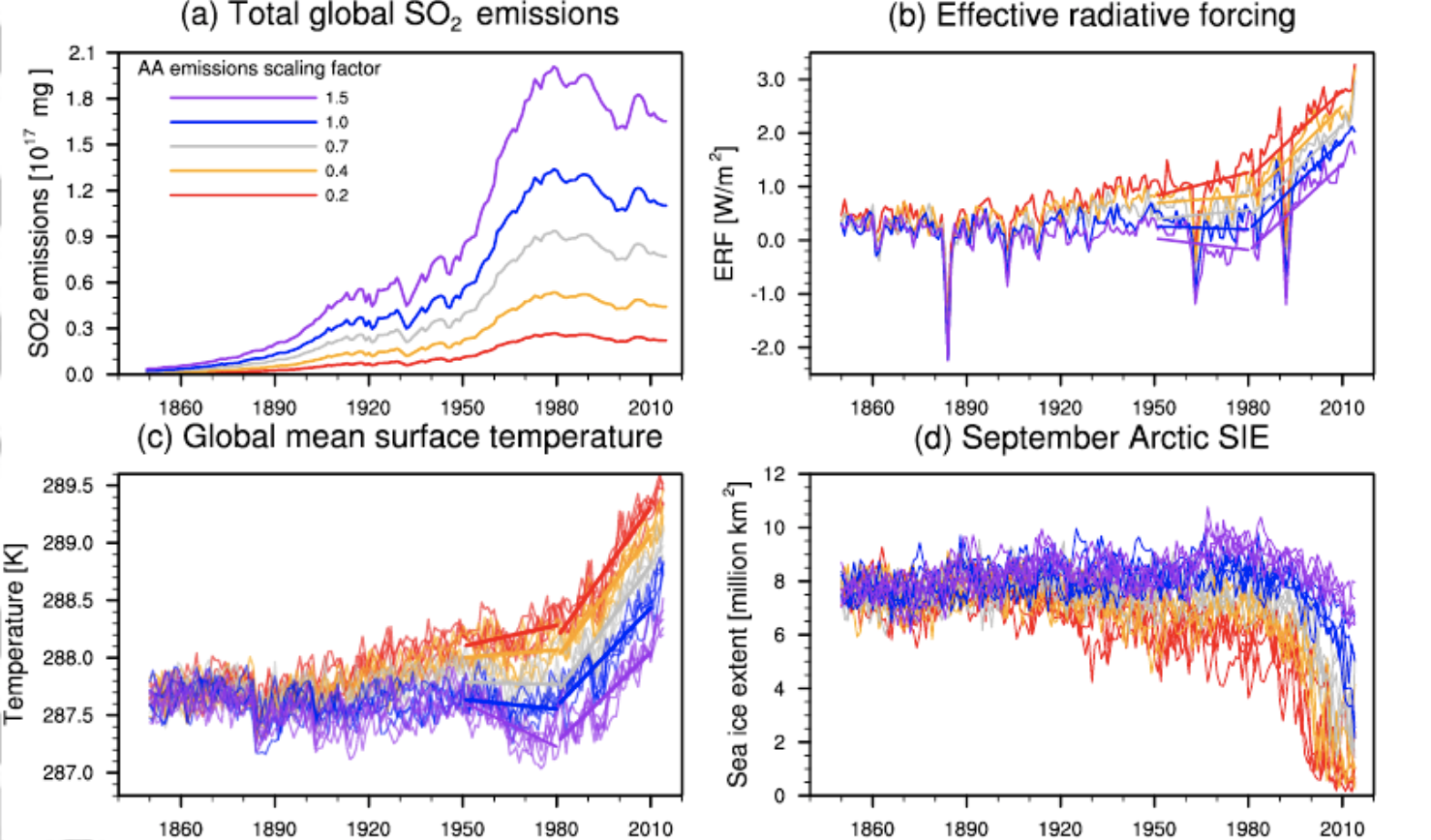Earth’s climate has warmed by approximately 0.85 degrees over the period from 1880 to 2012 [IPCC, 2013] due to anthropogenic emissions of greenhouse gases. However, the rate of warming throughout the twentieth and early twenty-first centuries has not been uniform, with periods of accelerated warming and cooling.
Guest post by Andrea Dittus
A key player in determining the historical evolution of global temperatures besides greenhouse gases are anthropogenic aerosols. Aerosols are airborne particles that scatter or absorb incoming solar radiation, and affect cloud properties, therefore altering the surface energy budget. Different aerosol species have different properties and climate impacts, but perhaps the most important aerosols in the context of global climate variability are sulphate aerosols, which account for a large proportion of anthropogenic aerosol. As a scattering aerosol, sulphate has a cooling effect on global climate and has partially offset some of the warming induced by emissions of greenhouse gases. Although we know that aerosols play an important role for global climate, the magnitude of historical aerosol forcing remains very uncertain.
In a recently published study, we analyse how varying anthropogenic aerosol emissions in a novel ensemble of climate model simulations with a development version of HadGEM3-GC3.1 affects the simulated evolution of global mean surface temperatures during the period from the 1850s to near present-day.

Five ensemble members are run for each of five scaling factors applied to anthropogenic aerosol emissions to sample a wide range of the uncertainty in historical aerosol forcing and account for internal variability in the climate system. We find that the magnitude of anthropogenic aerosol forcing affects global temperatures as early as the 1900s onwards, and the 1950-1980 period is particularly sensitive to the magnitude of aerosol forcing. This is expected, as this period corresponds to a period of rapid growth in aerosol emissions over Europe, North America and Asia.
From 1980 onwards, global temperature trends are less sensitive to changes in aerosol forcing, as declining aerosol emissions over North America and Europe are compensated by continued increases over Asia. The most important driver of simulated temperature trends in this period is forcing from greenhouse gases.
In this climate model, simulations with present-day aerosol forcing more negative than around -1 W/m2 are found to cool more in the mid-twentieth century than observed and agreement with observed trends is improved for simulations with weaker aerosol forcing. All ensemble members warm more rapidly than observations suggest for the period 1980-2014 regardless of aerosol scaling, which is likely related to the high sensitivity to greenhouse gases common to many climate models of this generation. Going forward, we hope these simulations will help us better understand how historical aerosol forcing has shaped climate variability in the twentieth and early twenty-first century beyond global temperatures.
Many thanks for this post, Ed. I did a bit of work on EarthCare the mission of which is exactly aerosols.
Hello Dr. Hawkins
I never wrote an article about aerosols in my French blog because, it’s too complicated for my limited understanding.
My point is about Black carbon… I was re-listening to Prof V Ramanathan (May 2018 lecture), in which he says black carbon (soot) is 2000 times more powerful at trapping heat compared to CO2.
This YALE study https://e360.yale.edu/features/carl_zimmer_black_carbon_and_global_warming_worse_than_thought
says:
“how much extra energy was being stored in the atmosphere thanks to black carbon. Climate scientists typically express that energy as watts per square meter of the Earth’s surface. The number they got — 1.1 watts — was enormous. Carbon dioxide, the biggest heat-trapper in the atmosphere, is responsible for an estimated 1.56 watts per square meter. Black carbon takes second place. “It took a while to convince ourselves it was correct,” says Doherty.”
I don’t really know what question to ask, so, I will let you free to give us your thoughts on this if you wish to.
Thank You very much
and please have a nice day
Le Climatoblogue